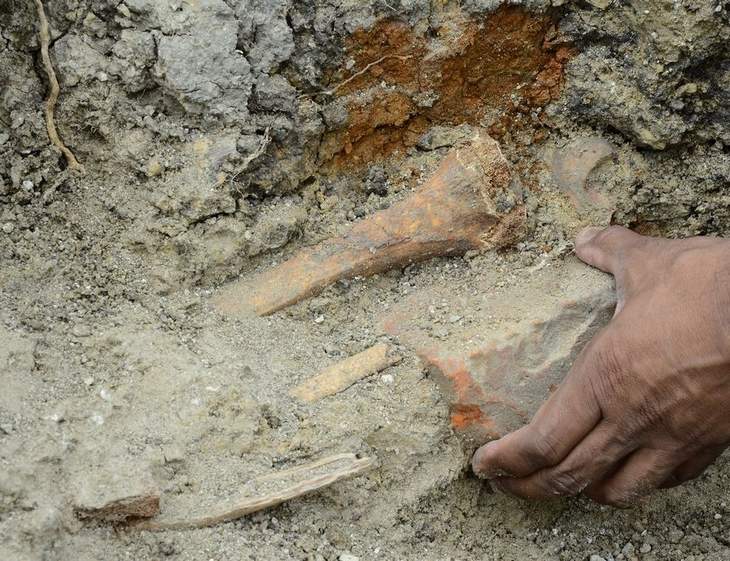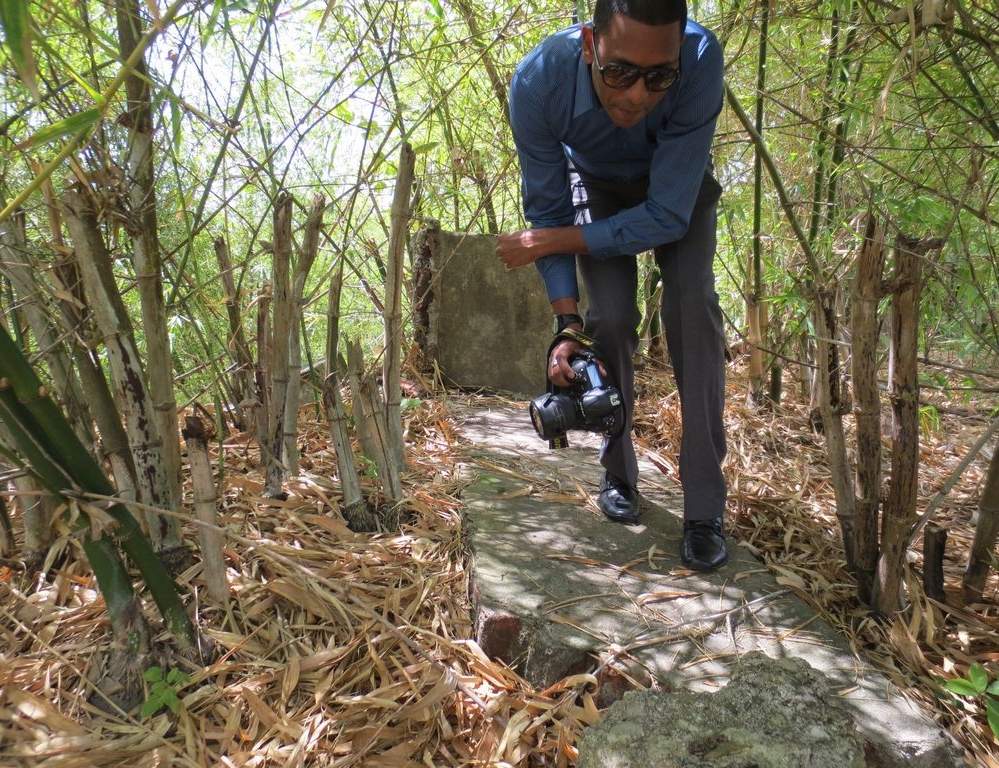|
Conservationists outraged as ancient burial site unearthed Human bones unearthed by a bulldozer clearing land at Rambert Village, near San Fernando. Photo: Dexter Phillip THE teeth belonged to someone who survived childhood. Still attached to the lower jawbone, the molars show signs of a hard life; deep cavities, worn enamel, gum disease. The jaw was part of the skull and skeleton unearth and dismembered by a bulldozer carving land near San Fernando for Trinidad's insatiable need for housing. The bulldozer would go on to expose the bones of an unknown number of people, likely African slaves, who lived and died on the La Ressource sugar estate, near San Fernando in the 1800s. The bones were exposed two weeks ago. People who care about the country's history have been outraged by the desecration. The police say they can't do much about it. The land belongs to a private developer with the right to do whatever he pleases. The bones were still there up to yesterday. Ribs, tibias, femurs, casket handles, coffin nails, strewn about the clay exposed by the earthmovers. Recent rains have exposed more. No one knows for sure what should or can be done. And if you think none of this is important, consider this. BORN in the year 1776, in St Vincent, French creole slave supplier Louis Bicaise sailed to Trinidad at age 34, and married into the Scottish Rambert family, then one of the wealthiest in the fertile Naparimas in south Trinidad. With his brother in law, Bicaise established the La Ressource Estate, and settled there with wife and children. In a short time he would become the sole owner of a prosperous plantation, enriched by the sweat and blood of the slaves that he bought and sold to surrounding plantations, including neighbouring Palmiste. A son, John Nelson Bicaise, would go on to become the only known West Indian slave trader, who made a fortune from the misery that was the trade in human beings, dealing from his station on the bank of the Rio Nunez, on Africa' West Coast in what is now the country of Guineau. The son would end up dying penniless and diseased, and was buried in Africa, having lost contact with his Trinidad family, whose estate suffered similar misfortune. The La Ressource estate was ruined as a result of the issues related to Emancipation, and Louis Bicaise would have to mortgage his plantation to an English merchant. In 1838, the year African slaves won full freedom, Bicaise died, leaving a wife, ten children, and the estate in debt. His body was entombed on a hilltop overlooking the estate, flanked on the east by a cemetery containing the remains of slaves and others who worked the plantation. Bicaise's wife Marie Rose Rambert, would also be buried on the hill thirty years later, and his last surviving son, Charles in 1882. A marble epitat inscribed in French on Bicaise's grave read: Louis Bicaise Natif De Saint Vincent Decedee A La Trinidad Le 13 Septembre 1838 A L'age De 62 Ans Il Faut Bon Fils , Bon Pere Bon Frere, Bon Parent & Bon Ami Les Excellents Qualites De Son Coeur Le Font Regretter Par Tous Ceux Qui Connurent Translation - Louis Bicaise, native of St. Vincent. Died in Trinidad on 13th September 1838 at the age of 62. He was a good son, good father, good brother, good kinsman and good friend. His big-heartedness has left him regretted by all those who knew him. Photographer Dexter Philip photographs the grave of 19th century splantation owner Louis Bicaise, located on a hilltop at Rambert Village, near San Fernando We know all of this because of the research of famed historian Fr Anthony De Verteuil, who with Belgian Chris-Arthur De Wilde, wrote about the Bicaise family in the book The Black Earth of South Naparima, and the work of historian/writer Angelo Bissessarsingh who, in his book Walking with the Ancestors, wrote about what remains of the Bicaise family tomb (the marble since broken up and inscriptions stolen), and of the slave cemetery (where up to the 1960s, the descendants still came to pay homage). Evidence of the Bicaise tombs can still be found, if you take that trip off Dumfries Road, Rambert Villave pull back the bushes and look for the Scottish firebricks (imported as a ballast in the holds of European sugar ships) which mark the burials, now surrounded by excavated land.
It was left up to Bissessarsingh, on his popular Facebook page Virtual Museum of Trinidad and Tobago three Saturdays ago, to alert conservationists about what had happened to the site. People wanted to know, where was the African Emancipation Committee? Didn't anyone at least understand the anthropological importance of what was being lost? By then, it was too late. The police did visit. The District Medical Officer was called in. He knew immediately that the bones belong to people who lived a long, long time ago. Divisional Commander of the Southern Division Senior Superintendent Irwin Hackshaw said historical sites were not the responsibility of the Trinidad and Tobago Police Service, but that his officers had responded to the report of an ancient burial site at Rambert Village, San Fernando, being desecrated. He said officers visited the site and contacted the relevant authorities. The items recovered, which included skeletal remains, were handed over to archaeologists, he said. The rest of the bones are scattered on the hillside, where more than seven feet of soil has been removed in some places. Crime scene tape was pulled across a mound of earth that was not yet excavated by the bulldozer. The Express later attempted to contact (by email and telephone) company said to be developing the land. There was never a response. “There is nothing we can do really. When we get a report we can contact the relevant people. That is it,” Hacksaw said. No one is more disturbed by it all, than chairman of the National Trust Professor Winston Suite, who has followed the events at Rambert Village, with despair. This was one of the most famous estates in south Trinidad and important to understanding how the country had developed to this point, he said. Yet too many people saw nothing wrong with destroying such a site, and now it was likely too late. Yes, Town and Country gave permission, but does it mean that one should go ahead and do whatever one wants at the expense of our national heritage? What's happening in the country? He asked. An absence of education. Maybe it was time to introduce history as a subject in the primary school curriculum. If people only knew, said Suite, they would probably attach more importance to things dating from the time when our ancestors were indentured or enslaved. What's the National Trust doing? The National Trust is tasked with listing and acquiring heritage property, permanently preserving lands that are heritage sites and as far as practicable, retaining their natural features and conserving the animal and plant life, in addition to preserving, maintaining, repairing and servicing buildings of historical value. But with the number of sites that need protection, the job in daunting, especially since it has been inactive for more than a decade. Professor Suite is asking that citizens get involved. The National Trust is organising visits of historic sites around the country - the company villages of Moruga, the Moruga Museum, Devil's Woodyard, the railway tunnel in Tabaquite, the Banwari site, Temple in the Sea. And there is the Nelson Island Experience of Tubal Uriah Butler on June 28th (contact 308-8197, 390-6521). Talk has begun again about trying to establish museums in every regional corporation in the country. The National Trust meets today with Chairman of the Sangre Grande Regional Corporation Terry Rondon who wants to demolish the old post office, court house and fire station, some of the buildings more than 100 years old. Professor Suite is going to try saving the buildings. You can log on to www.trinidadexpress.com to see additional photographs and videos of the gravesite and tomb.
0 Comments
Leave a Reply. |
T&T news blogThe intent of this blog is to bring some news from home and other fun items. If you enjoy what you read, please leave us a comment.. Archives
May 2025
Categories
All
|



 RSS Feed
RSS Feed